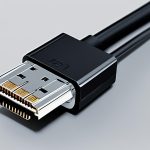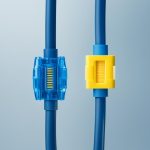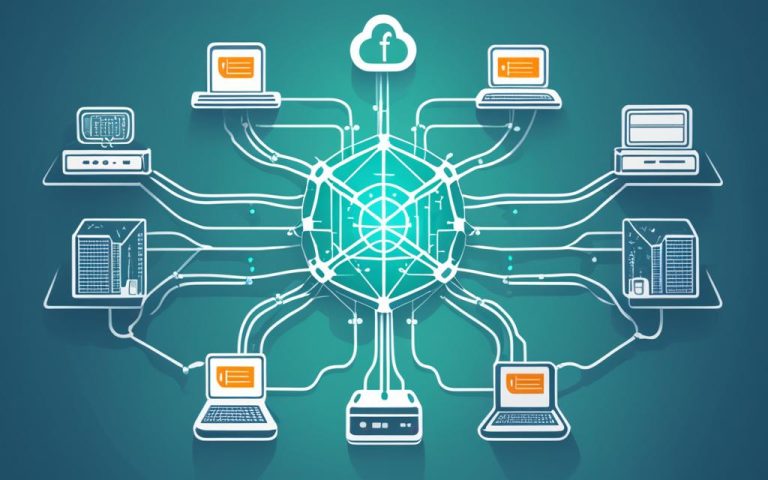As technology gets better, network admins must connect modern switches for the best network performance. This guide offers key steps and tips for linking two modern switches well.
First, it’s vital to read and understand the technical setup for the switch. Data1 shows how important it is to be precise and knowledgeable. This ensures a successful connection by focusing on details and understanding the setup steps.
Before connecting, admins need to pick the right way to link the switches. Data1 says only two out of five methods work for connecting with a straight-through cable. This shows the need for careful thought and choice based on the network’s needs.
Also, admins should look into Virtual Local Area Networks (VLANs). Data2 explains VLANs can make broadcasts smaller, cut down on traffic, and reduce bandwidth use. They help manage the network by grouping devices logically and controlling traffic between groups.
It’s also key to know the difference between Layer 2 and Layer 3 switches. Data3 shows Layer 2 switches are cheaper and good for small to medium networks. Layer 3 switches are better for big networks needing routing and fast data transfer.
To set up modern switches right, admins should get to know CLI and network tools. These tools help set up switches and keep networks running well. For more info, check out guides on using Cisco switches with CLI and Network Configuration Manager.
Key Takeaways:
- Read and understand technical instructions for successful switch configuration (Statistical data1)
- Choose the appropriate method for connecting modern switches based on specific requirements and network setup (Statistical data1)
- Consider the benefits of VLANs in reducing broadcast traffic and managing logical groups of stations (Statistical data2)
- Understand the differences between Layer 2 and Layer 3 switches in terms of cost, routing capabilities, and data transfer (Statistical data3)
- Familiarize yourself with CLI and network configuration management tools for efficient switch configuration
The Role of Network Monitoring and Management in Maintaining Network Performance
Network monitoring and management are key to keeping data flowing smoothly in an organization. As technology gets more complex, network admins need new tools and methods to manage and check network performance.
These tools help make networks run better, stay available, and keep data safe. Network admins use tasks and protocols like SNMP (Simple Network Management Protocol)4 to manage devices from afar.
Managing networks involves planning, designing, and controlling4. These steps help admins create a solid plan for managing the network. They also focus on controlling devices, monitoring traffic, and keeping data safe from unauthorized access4.
Finding and fixing network problems is a big part of network monitoring and management4. This helps keep the network running smoothly and quickly fixes issues. Tracking network use also helps make sure resources are used well4.
Keeping an eye on network performance is crucial4. It helps spot problems, improve bandwidth, and keep the network running well. Keeping networks safe from unauthorized access is also key4.
Good network monitoring and management boost network performance and availability. With more people working remotely, managing networks well is vital for security and keeping services running smoothly4. This helps predict future needs, use resources better, and save money4.
Statistics show that network downtime can be costly5. So, having strong network monitoring systems is crucial. SNMP is widely used for managing networks5.
Monitoring devices at different times helps keep track of their status5. High availability means networks stay connected and send out alerts quickly when there are problems5. Systems need to show important info clearly and quickly to help fix issues fast5. They should also handle more devices as needed5.
Security features in these systems protect against unauthorized access and attacks5. They work well with different devices and vendors to collect performance data5.
Benefits of Network Monitoring and Management
Network monitoring and management have many benefits. They give admins a clear view of the network’s health and performance6. This helps them make better decisions and fix problems quickly.
They also help find and fix downtime fast, keeping networks running smoothly6. By tackling issues in real-time, networks stay available and perform well.
These systems also help make networks run better. They collect data on how the network is doing, helping admins find ways to improve6. By using this info, networks can work more efficiently and save resources.
Challenges in Network Monitoring and Management
Network admins face challenges in monitoring and managing networks. One big challenge is keeping track of devices with changing IP addresses6. They need good IP address management to monitor all devices properly.
Managing complex networks across different locations is another challenge6. Centralized management solutions help admins keep an eye on performance and security everywhere.
Cloud and hybrid networks also present challenges6. Admins need to adapt their systems to work well with these networks. This includes integrating with cloud platforms, managing visibility, and addressing security concerns.
Deployment Options: On-Premises vs. Cloud-Based
Organizations can choose between on-premises or cloud-based network monitoring and management6. On-premises gives better control and security. Cloud-based options offer convenience, reliability, and cost savings. They let organizations manage monitoring infrastructure without the hassle, scale easily, and access data from anywhere.
| Statistic | Reference |
|---|---|
| SNMP (Simple Network Management Protocol) | 1 |
| Steps of network management | 1 |
| Tasks of network management | 1 |
| Network downtime impact | 2 |
| Monitoring intervals for network devices | 2 |
| High availability in network monitoring systems | 2 |
| Scalability in network monitoring systems | 2 |
| Security features in network monitoring systems | 2 |
| Benefits of network management | 3 |
| Challenges in network management | 3 |
| Deployment options | 3 |
Understanding the Current Infrastructure
Traditional network monitoring can struggle in virtual and cloud settings. Here, IP addresses change often, making it hard to track traffic. To tackle this, network admins must create a baseline of normal network performance. This baseline includes tracking bandwidth, traffic patterns, and user numbers.
It sets the standard for what’s normal and helps spot problems. This way, admins can set alerts and know when something’s off.
Today, network admins are key to keeping our digital world running smoothly. With more businesses going online, the need for skilled admins has skyrocketed7. They handle the daily tasks of keeping networks running, from LANs to the Internet7.
While system admins focus on software, network admins are all about hardware and connections7. They’re experts in making sure everything connects and works well together.
Modern network admins need to know about cloud services and cybersecurity too. They keep networks safe and running smoothly, even in complex cloud environments7. They usually have degrees in network admin or computer science7. Certifications like Cisco’s CCNA or CompTIA’s Network+ show they’re up to speed with the latest in networking7.
But their job isn’t just about keeping things running. They must keep learning to keep up with new tech and methods7. They work with other IT teams, manage support staff, and plan for the future of networks7. Their skills are in demand in many fields, from tech to healthcare7.
Important Data Points to Measure
Managing network performance means collecting and analyzing the right data. It’s key for a network to run smoothly. Network admins should keep an eye on both traditional and specific metrics.
It’s important to watch the network’s overall performance. Look at how busy it is, packet losses, and NetFlow stats8. This helps admins see if the network is working well and spot any problems.
Nowadays, voice and video traffic is a big deal. So, checking latency and jitter is a must8. High latency or jitter can really slow things down and make users unhappy. Keeping an eye on these can help fix issues fast.
Also, checking how apps perform is crucial for a good network. Look at how fast they respond and how users feel about it8. This tells admins if apps are slow or not working right. They can then work on making things better for everyone.
In short, admins should keep an eye on various data to check how the network and apps are doing. By watching things like how busy the network is, packet losses, NetFlow stats, latency, jitter, response times, and user experience, they can make smart choices. This keeps the network running smoothly.
- Catchpoint – Network Admin Guide: Inter-VLAN
- Pearson IT Certification – Ethernet Fundamentals
- O’Reilly – Ethernet Switches
Proactive Testing for Avoiding Performance Problems
Proactive testing is key in keeping networks running smoothly. It helps network managers spot problems before they hit users. By testing network performance often and fixing issues early, companies can keep services running well and users happy.
Testing VoIP phones by making them call each other is a smart move. It lets network managers check things like delay, lost packets, and MOS (Mean Opinion Score). This shows how well calls sound, helping find and fix problems that could mess up voice calls on the network9.
Benefits of Proactive Testing
Using proactive testing has big benefits for network performance. It finds and fixes problems before they cause trouble, avoiding service outages10. This means less money lost from service issues, fewer customer complaints, and less chance of losing customers10.
It also boosts productivity and service quality by quickly solving network problems. By keeping an eye on the network and fixing issues fast, companies can cut down on service interruptions. This makes the user experience better10.
Effective Proactive Testing Strategies
To test proactively, network teams should use the right tools for their setup. These tools help in fixing and watching the network, giving insights into how it’s doing and where it might fail10.
Ping tests check if the network is connected and spot lost packets. They give info on how the network is doing, like how many packets are lost, which could mean problems10.
Traceroute is another tool for testing. It shows the path data takes and the delay, helping find where the network fails or slows down10.
For a deeper check, tools like MTR (Matt’s Traceroute) are useful. They combine tracing and pinging to show routers and their performance. This can point out issues that could affect the whole network10.
The Role of NPM in Proactive Testing
Network Performance Management (NPM) tools are key for proactive testing. They watch the network in real-time and alert admins to problems, so they can fix them fast11.
NPM also helps with planning for the future by looking at past data and predicting growth. This ensures the network can handle more users without slowing down, meeting business needs11.
Plus, NPM keeps an eye on how the network affects users. It looks at things like how fast apps load and how well services work. This helps admins tackle issues that could make users unhappy or less productive11.
Developing the Right Tool Portfolio
Having the right tools is key for network monitoring and management. Network admins use SNMP-capable network monitoring tools to keep an eye on the network’s health and performance.
A NetFlow analyzer is a must-have for network admins. It sits in routers and switches, letting admins see how the network is used. This info helps spot and fix performance issues early12.
Active and passive performance testing tools are also vital. They check how well the network works and how fast it responds. Active testing sends test traffic, while passive testing looks at real network data. Together, they give a full view of the network’s health and where it can get better12.
Choosing the right tools is a big deal for network admins. It’s important to pick tools that fit the job and perform well. They should support SNMP for monitoring devices and have easy-to-use dashboards for data analysis12.
For more info, check out these links:
These resources help network admins stay updated and learn new best practices. With the right tools, admins can keep networks running smoothly and efficiently12.
Common Protocols and Their Port Usage
| Protocol | TCP/UDP Port |
|---|---|
| HTTP | 80 |
| HTTPS | 443 |
| FTP | 20, 21 |
| SSH | 22 |
Networking uses specific ports for communication. HTTP uses port 80, HTTPS uses port 443, and FTP uses ports 20 and 21. Knowing these ports helps admins set up firewalls and routers correctly12.
As networks get faster, admins need to keep up. The IEEE’s 802.3bz standard shows we’re moving to faster Ethernet speeds13.
Cisco’s Catalyst Multigigabit tech supports Wi-Fi 6 technology. This means networks can handle more devices and keep up with high-speed demands13.
Power over Ethernet (PoE) is important too. Cisco’s Universal Power Over Ethernet Plus supports up to 90W per port. This means devices like Wi-Fi APs and cameras get power through the network, making setup easier13.
Scalability is key in network design. Networks might need to grow a lot over time. Cisco DNA Center makes managing devices easier, helping networks grow and adapt13.
Cisco’s SD-Access supports IoT trends with TrustSec and other technologies. It lets admins set policies and manage access, improving security and flexibility13.
When designing campus LANs, admins have options. Traditional, Simplified, and Cisco Software Defined Access each have their benefits. This lets admins tailor the network to their organization’s needs13.
VLANs are a big part of campus LAN design. They reduce traffic by isolating areas, making networks more efficient. VLANs can be set up in two ways: by port or tag14.
For voice traffic, Voice VLANs are useful. They prioritize VoIP traffic, ensuring calls go smoothly and without delay14.
Configuring a Cisco Switch with CLI
Using the Command Line Interface (CLI) to set up a Cisco switch gives network admins full control over the switch’s settings. This process involves several steps to ensure the switch is set up and managed well. CLI commands help make sure the network runs securely and efficiently.
Step 1: Logging In
First, admins log into the Cisco switch using an emulator. This gives them direct access to the switch’s CLI. It makes interacting with the device’s settings easy.
Step 2: Setting the Hostname
It’s key to give the Cisco switch a unique hostname in the network. This makes it easier to identify and manage the switch. It helps admins work more efficiently.
Step 3: Configuring IP Address Management
For remote network management, setting the IP address is crucial. This lets admins connect to the switch via SSH or Telnet. It ensures they can manage the switch from anywhere.
Step 4: Enhancing Security with an Administration Password
Protecting the Cisco switch’s privileged mode is essential for security. Setting an administration password keeps only authorized people out. This stops unauthorized changes or harmful actions.
Step 5: Changing Default Switch Credentials
For extra security, changing the default switch settings and making new user accounts is a must. This stops unauthorized access to the switch, making the network safer.
Step 6: Establishing the Default Gateway
Setting the default gateway is key for remote access and network communication. It ensures the switch can talk to other devices in the network smoothly.
Step 7: Configuring Secure Passwords
Secure passwords for console, Telnet, and auxiliary ports are a must. This step keeps the network safe from unauthorized access and boosts security.
Step 8: Setting Up Static Routes
For specific routes, setting a static route on the Cisco switch helps with packet forwarding. This makes sure data moves reliably in the network, even when dynamic routing fails.
Step 9: Configuring Interface Descriptions
For better network management, setting interface descriptions is vital. It helps admins identify and manage different network parts easily. This makes troubleshooting and setting up faster.
Step 10: Managing Data Transmission Efficiency with Duplex Mode
Choosing the right duplex mode is key for data flow efficiency. It prevents network congestion and keeps data moving smoothly.
Step 11: Saving the Configuration
After setting everything up, saving the changes to the switch’s memory is a must. Using the “write memory” command keeps the new settings, even after a reboot.
Managing many devices at once can be hard. But, Cisco’s Network Configuration Manager’s Configlet feature helps. It automates the setup process, making it faster and more accurate for admins.
Configuration Steps for Cisco Switch with CLI
| Step | Description |
|---|---|
| 1 | Logging In |
| 2 | Setting the Hostname |
| 3 | Configuring IP Address Management |
| 4 | Enhancing Security with an Administration Password |
| 5 | Changing Default Switch Credentials |
| 6 | Establishing the Default Gateway |
| 7 | Configuring Secure Passwords |
| 8 | Setting Up Static Routes |
| 9 | Configuring Interface Descriptions |
| 10 | Managing Data Transmission Efficiency with Duplex Mode |
| 11 | Saving the Configuration |
By following these steps, network admins can set up Cisco switches with CLI well. This ensures the network runs securely and efficiently.
Statistical data from link 1:11 configuration steps are provided to configure and manage a Cisco switch using CLI15.
Configuring a Cisco Switch with Network Configuration Manager
Network Configuration Manager (NCM) makes it easy for network admins to set up Cisco switches. It uses the Configlet feature to automate the process. This means admins can send commands to many devices at once, keeping settings the same everywhere.
Here’s how to set up a Cisco switch with NCM’s Configlet:
- Setting the hostname: It’s key to give each switch a unique name. Use the
hostnamecommand for this15. - IP address management: Switches need IP addresses to talk on the network. Use the
ip addresscommand to set these up16. - Administration password: Keep the switch safe with a password. Set it with the
enable secretorenable passwordcommand16. - Default gateway: This sets up routing for traffic outside the local area. Use the
ip default-gatewaycommand for this16. - Console and auxiliary port passwords: Keep physical access secure with passwords for the console and auxiliary ports. Use the
line consoleandline auxcommands for this15. - Static routes: For networks without enough dynamic routes, set static ones. Use the
ip routecommand for this15. - Interface descriptions: Give switch interfaces clear names for better management. Use the
descriptioncommand for this15. - Duplex mode: This setting improves network speed. Use the
duplexcommand to set it15.
After using NCM’s Configlet, the switch will be ready for your network. This tool helps admins work faster and keep settings the same across devices.
Network Administrator’s Tips for Successful Switch Configuration
Setting up switches right is key for network performance. Follow these tips to make sure your network runs smoothly.
1. Avoid Creating Loops in Switch Connections17
Don’t let loops happen when you connect switches. Experts say this is a big no-no. Loops slow down your network and cause problems. Plan your connections well to avoid this.
2. Utilize Crossover Cables for Unmanaged Switches17
For connecting unmanaged switches, use crossover cables. This is what pros suggest. It helps your network work better and faster.
3. Optimize Switch Performance with Fastest Port Speed17
Use the fastest port speed you can for better network speed. This is what many experts recommend. Also, keep heavy and light users on different switches to reduce traffic.
4. Consider Fiber Optic Cables for Switch Connections17
Think about using fiber optic cables for your switches. They offer more bandwidth and can go further. This is great for fast and reliable connections.
5. Implement Spanning-Tree Protocol (STP) to Prevent Loops1718
Use Spanning-Tree Protocol (STP) to stop loops. It’s important, as experts say. This protocol keeps your network stable and loop-free. It’s key for a well-configured network.
6. Leverage EtherChannel for Switch Redundancy1719,
Use EtherChannel for switch redundancy. It’s a good idea, as many say. This tech combines links into one, giving you more bandwidth and reliability.
Here are some more tips for switch configuration success:
- Use the same naming for switches to make managing easier.
- Set strong passwords to keep your switches safe.
- Watch your network closely to fix problems fast.
- Update your switch software regularly for better performance and security.
| Tips for Successful Switch Configuration | References |
|---|---|
| Avoid creating loops in switch connections | 17 |
| Utilize crossover cables for unmanaged switches | 17 |
| Optimize switch performance with fastest port speed | 17 |
| Consider fiber optic cables for switch connections | 17 |
| Implement spanning-tree protocol (STP) to prevent loops | 1718, |
| Leverage EtherChannel for switch redundancy | 1719, |
Follow these tips to make sure your switch setup works well. This means better performance, stability, and security for your network.
Conclusion
Today, network administrators are key to keeping networks running smoothly. They connect modern switches and follow best practices to build strong, efficient networks20.
These professionals need a wide range of skills. They must know about network management, server administration, and TCP/IP protocols. They also need to be good at solving problems, thinking critically, and explaining complex ideas simply20.
When setting up switches, admins need to understand how MAC addresses work and the different switching methods. Switches use MAC addresses to send data and have two main ways to switch data: store-and-forward and cut-through21. Store-and-forward checks for errors to make sure data is sent correctly. Cut-through is faster, making quick decisions on where to send data21.
Switches have taken over from hubs, offering better network performance. They work in full-duplex mode, which means no collisions. This stops the problems seen in half-duplex Ethernet networks22. To stop attacks, admins use security steps and ensure hosts talk to each other directly22. Also, features like IEEE 802.1w help stop broadcast storms when connecting switches22.
In summary, network admins are vital for keeping networks running well. They connect modern switches and use best practices. By keeping up with new tech and learning, they can handle complex networks effectively20.
FAQ
What is the role of network monitoring and management in maintaining network performance?
Network monitoring and management keep data moving smoothly in an organization. They handle Quality of Service (QoS) needs, BYOD policies, and new tech like cloud computing.
What challenges do traditional network monitoring techniques face in virtualized and cloud environments?
Traditional methods struggle in virtual and cloud settings. IP addresses change often, making it hard to track traffic.
What important data points should network administrators measure for network performance?
They should watch traditional metrics like usage, packet losses, and NetFlow stats. Also, keep an eye on latency, jitter, app performance, and user satisfaction to understand network health.
Why is proactive testing important for avoiding performance problems?
Proactive testing helps prevent network issues. By checking performance early, network managers can fix problems before they affect users.
What tools are essential for comprehensive network monitoring?
For full network monitoring, you need tools that support SNMP and show network status. NetFlow analyzers and testing tools are key for a thorough check.
How can a Cisco switch be configured using the Command Line Interface (CLI)?
To set up a Cisco switch with the CLI, start by logging in. Then, give it a unique name, manage IP addresses, and set a secure password. Don’t forget to update default settings and configure more options.
How can a Cisco switch be configured using Network Configuration Manager?
Network Configuration Manager makes setting up Cisco switches easier with its Configlet feature. It lets admins send commands to many devices at once, automating the setup.
What tips can network administrators follow for successful switch configuration?
For switch setup success, use clear names, set baseline metrics, and keep an eye on network health. Add security, update firmware, and use automation to keep devices consistent.
How can network administrators successfully connect modern switches?
By following the article’s steps and tips, network admins can set up and manage their switches well.
What should network administrators do to ensure optimal network performance?
They should keep up with new tech and tools, adjust to network changes, and ensure data flows smoothly in the organization.
Source Links
- https://www.transtutors.com/questions/a-network-administrator-is-connecting-two-modern-switches-using-a-straight-through-c-10072403.htm – (Solved) – A network administrator is connecting two modern switches using a… (1 Answer) | Transtutors
- https://www.oreilly.com/library/view/packet-guide-to/9781449311315/ch04.html – Packet Guide to Routing and Switching
- https://www.manageengine.com/products/oputils/tech-topics/layer2-vs-layer3-switch.html – Switch Port & IP Address Management Software by ManageEngine OpUtils
- https://www.kaseya.com/blog/network-management/ – Network Management: How It Works and Why It’s Important
- https://www.manageengine.com/network-monitoring/basics-of-network-monitoring.html – Network Monitoring Software by ManageEngine OpManager
- https://www.techtarget.com/searchnetworking/definition/network-management – What is network management and why is it important?
- https://www.ituonline.com/blogs/network-administrator/ – Network Administrator : Diving Deep Into The Role Of A Computer Network Admin – ITU Online
- https://www.catchpoint.com/network-admin-guide/inter-vlan-routing – Inter-VLAN Routing: Configuration Examples
- https://www.catchpoint.com/network-admin-guide/switching-loops – Switching Loops: The Best Practices To Avoid Them
- https://netbeez.net/blog/network-troubleshooting/ – Network Troubleshooting
- https://obkio.com/blog/network-performance-management/ – A Proactive Approach to Network Performance Management – Obkio
- https://www.infosecinstitute.com/resources/professional-development/top-50-network-administrator-interview-questions/ – Top 50 network administrator interview questions
- https://www.cisco.com/c/en/us/td/docs/solutions/CVD/Campus/cisco-campus-lan-wlan-design-guide.html – {sectionTitle} – Campus LAN and Wireless LAN Solution Design Guide
- https://www.ninjaone.com/blog/what-is-vlan/ – What is VLAN in IT and Networking? | NinjaOne
- https://www.manageengine.com/network-configuration-manager/configure-cisco-switch.html – Network Configuration Management by ManageEngine Network Configuration Manager
- https://www.cisco.com/c/en/us/td/docs/ios/fundamentals/configuration/guide/12_2sr/cf_12_2sr_book/cf_cli-basics.html – Cisco IOS Configuration Fundamentals Configuration Guide, Release 12.2SR – Using the Cisco IOS Command-Line Interface [Cisco IOS Software Releases 12.2 SR]
- https://community.spiceworks.com/t/connecting-multiple-switches-together/250523 – connecting multiple switches together
- https://www.linkedin.com/advice/0/what-best-practices-configuring-switch-optimal-kbrhc – What are the best practices for configuring a switch for optimal performance?
- https://veemost.com/maximizing-network-efficiency-tips-for-configuring-cisco-switches/ – Maximizing Network Efficiency: Cisco Switch Configuration Tips
- https://www.ituonline.com/blogs/computer-network-administrator/ – Computer Network Administrator : Masters Of The Digital Universe – ITU Online
- https://www.ciscopress.com/articles/article.asp?p=2181835&seqNum=5 – The Switched Environment (1.2) > Cisco Networking Academy’s Introduction to Switched Networks
- https://thecybersecurityman.com/2018/07/18/an-intermediate-level-discussion-on-network-switches/ – An Intermediate-level Discussion on Network Switches



















